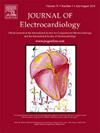Time-frequency analysis of high-frequency power profile within the QRS complex in patients with ventricular tachycardia using wavelet transform
IF 1.2
4区 医学
Q3 CARDIAC & CARDIOVASCULAR SYSTEMS
引用次数: 0
Abstract
Background
Time-frequency analysis using continuous wavelet transform enables the detection of hidden frequency power within the QRS complex in electrocardiography. These frequency profiles may reflect myocardial damage and electrical dispersion. This study evaluated the frequency power profile in patients with a history of ventricular tachycardia (VT) using time-frequency analysis and assessed changes in the profile after catheter ablation.
Methods
Thirteen patients with a history of VT and 15 without who underwent implantable cardioverter-defibrillator implantation for secondary and primary prevention, respectively, were included. The time-frequency powers were calculated from QRS onset to the beginning of the T-wave in lead V5 on 3-min electrocardiography pre-implantation using continuous wavelet transform analysis. The frequency power of each scale band (40, 80, 150, 200, and 250 Hz) was evaluated using the mean of three continuous beats.
Results
The signal powers in high-frequency bands against that of 80 Hz were significantly higher in the VT group than in the non-VT group (250/80 Hz: 0.214 ± 0.060 vs. 0.146 ± 0.055, p = 0.004; 200/80 Hz: 0.282 ± 0.086 vs. 0.211 ± 0.082, p = 0.036; 150/80 Hz: 0.425 ± 0.118 vs. 0.341 ± 0.097, p = 0.049). Among 11 patients undergoing VT ablation in the secondary prevention group, the high-frequency component ratio significantly decreased post-ablation (250/80 Hz: 0.220 ± 0.062 to 0.183 ± 0.067, p = 0.015; 150/80 Hz: 0.424 ± 0.115 to 0.383 ± 0.108, p = 0.031). Peak signal powers of 250 Hz were detected within the QRS complex in all patients, with significant prolongation after ablation.
Conclusion
The distribution shift of the powers in the high-frequency bands was relevant in patients with VT. The time-frequency analysis was useful for stratifying ventricular arrhythmia risk.
应用小波变换分析室性心动过速患者QRS复合体高频功率谱时频
使用连续小波变换的时频分析可以检测心电图中QRS复合体内隐藏的频率功率。这些频率分布可能反映心肌损伤和电弥散。本研究利用时频分析评估了有室性心动过速(VT)病史患者的频率功率谱,并评估了导管消融后频率功率谱的变化。方法13例有室性心动过速病史,15例无室性心动过速病史,均行心脏转复除颤器植入术进行二级和一级预防。采用连续小波变换分析,计算心电图植入前3 min从QRS开始到V5导联t波开始的时频功率。使用连续三拍的平均值来评估每个刻度波段(40、80、150、200和250 Hz)的频率功率。结果VT组80 Hz高频信号功率显著高于非VT组(250/80 Hz: 0.214±0.060 vs 0.146±0.055,p = 0.004;200/80 Hz: 0.282±0.086和0.211±0.082,p = 0.036;150/80 Hz: 0.425±0.118和0.341±0.097,p = 0.049)。二级预防组11例行室速消融的患者中,高频分量比显著降低(250/80 Hz: 0.220±0.062 ~ 0.183±0.067,p = 0.015;150/80 Hz: 0.424±0.115,0.383±0.108,p = 0.031)。在所有患者的QRS复合体内检测到250 Hz的峰值信号功率,消融后显著延长。结论室性心律失常患者高频波段功率的分布移位与室速相关,时频分析可用于室性心律失常风险分层。
本文章由计算机程序翻译,如有差异,请以英文原文为准。
求助全文
约1分钟内获得全文
求助全文
来源期刊

Journal of electrocardiology
医学-心血管系统
CiteScore
2.70
自引率
7.70%
发文量
152
审稿时长
38 days
期刊介绍:
The Journal of Electrocardiology is devoted exclusively to clinical and experimental studies of the electrical activities of the heart. It seeks to contribute significantly to the accuracy of diagnosis and prognosis and the effective treatment, prevention, or delay of heart disease. Editorial contents include electrocardiography, vectorcardiography, arrhythmias, membrane action potential, cardiac pacing, monitoring defibrillation, instrumentation, drug effects, and computer applications.
 求助内容:
求助内容: 应助结果提醒方式:
应助结果提醒方式:


